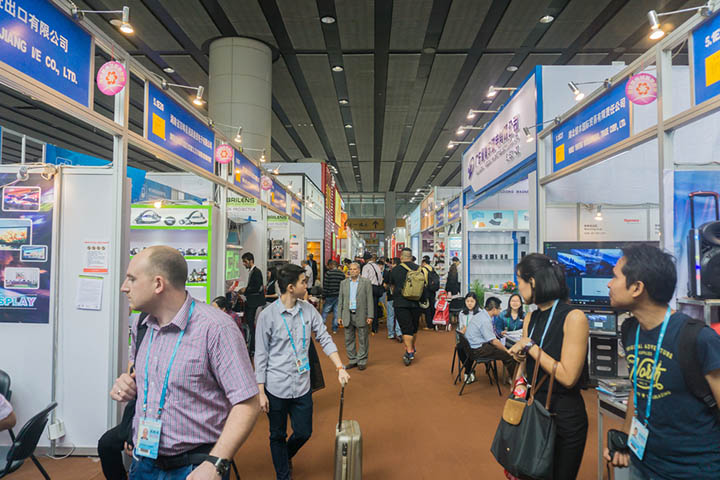News September 14, 2021
China COVID Outbreak Compels Canton Fair to Cut Days
Pre-pandemic, promo products leaders attended the fair in numbers. The virus flare-up also could affect global supply chains, though there was some good news on port reopening.
China’s oldest and biggest trade fair is reducing its planned number of days by two-thirds due to a nearby outbreak of COVID-19, which has also prompted societal lockdowns that could hamper production at factories and transport of goods, thereby placing more pressure on global supply chains.

Attendees walk the floor at the Canton Fair in the pre-pandemic days of 2017.
The Canton Fair, which was traditionally attended by many sourcing pros and executives in the North American promotional products industry prior to the pandemic, will run just five days, down from 15.
Scheduled to begin Oct. 15, this incarnation of the Canton Fair is still in line to be the first in-person version of the event since October 2019. Three subsequent fairs were held virtually as COVID concerns compelled the cancellation of in-person events.
Established in 1957, the Canton Fair is held biannually in Guangzhou, Guangdong province. A flare-up in COVID cases and related lockdown measures in the neighboring southeastern province of Fujian, however, drove fair organizers to slash the number of days.
Ren Hongbin, Vice Minister of Commerce, introduced at the press conference that to coordinate COVID-19 containment, the 130th #CantonFair will be adjusted from three phases to one phase. The 130th Canton Fair will be held both online and offline for five days (October 15 to 19). pic.twitter.com/ZjVij6O6tC
— Canton Fair (@cantonfair) September 14, 2021
The October 2021 in-person fair is shaping up to be a shadow of its former self. Floor space is down from a pre-pandemic 13 million square feet to 4.3 million square feet. A limited number of China-based buyers and exporters are expected to attend, with approximately 7,500 exhibitors on tap.
Before COVID, 20,000 exhibitors were common. At the show in Oct. 2019, 186,000 buyers attended. The top three non-China countries by attendance were Hong Kong, the United States and India.
Some China-based exporters told the South China Morning Post that the fair as an in-person event has diminished in relevance. The SCMP reported that about 26,000 exhibitors live-streamed their displays at the three virtual fairs in April 2021, and June and October 2020.
“Due to the pandemic, we as exporters are getting used to approaching customers and selling online, and the proportion of online sales is becoming larger and larger,” Linda Zhang, a sales manager for a Zhejiang-based producer of smart home devices, told the Post.
Societal Shutdowns
Meanwhile, the latest COVID outbreak in China, driven by the more infectious delta variant, has spurred officials in China to institute restrictions that include locking down Xiamen, a coastal city of 4.5 million people in Fujian province that is reportedly a hub for already hard-to-source electronic components.
Residents are banned from leaving the city, save for exceptional circumstances. Bars, gyms, libraries and theaters have been closed, and residential compounds and villages were closed off, The Times of India reported.
To the northeast of Xiamen, the city of Putian has effectively been sealed off. Residents were instructed not to leave after authorities identified 20 new COVID cases on Sunday, Sept. 12, according to reports.
China’s busiest container-shipping ports in Shanghai, Ningbo begin to reopen after Typhoon Chanthu https://t.co/8cv04jTPW8
— South China Morning Post (@SCMPNews) September 14, 2021
China is the world’s manufacturing power, and the majority of promotional products sold in the North American market are produced there. Societal disruptions in China can negatively affect global supply chains. If, for example, factories are closed or production workers can’t go to work because they’re quarantining, in-demand materials can’t be processed, and products cannot be made.
In a positive development, terminals at the Chinese ports of Shanghai and Ningbo-Zhoushan are again processing containers at several terminals. The ports, two of the world’s busiest, were briefly shut down due to Typhoon Chanthu. Nonetheless, while a resumption of activities was good, even minor disruptions at pivotal import/export ports can reverberate through global supply chains.
“Any shutdown due to weather, even a temporary one, could further slow supply chains, which are already stretched thin as exporters attempt to ship more ahead of the holiday season,” Nick Austin, director of weather analytics and senior meteorologist at FreightWaves, a freight intelligence provider, told the South China Morning Post.
